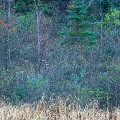For landscapes, I prefer
this large format (LF) camera, because it produces
an image which matches my perception of a visually rich world.
First, because the size of the film is 5x7 inches (12.7cm x 17.8cm),
the camera records an amazing amount of detail, 25 times what is
contained in a regular 135 (24mm x 36mm) frame.
Everything which I saw is on the
film, and even more. When I examine my transparencies under a lupe, I
notice from time to time details which escaped me when I was looking
at the scene.
Note that what I display here does not even capture the full detail in
the original transparency, but only a quarter of it: the scanning was
done only at a resolution necessary to produce a 24x30 inches (60 x
75 cm) print, which is 6000 x 9000 pixels. However, the transparency
has a resolution of at least 50 lpm, is 5x7 inches (12.7cm x 17.8cm) and
therefore could have been used to produce a quality digital image file at least four times larger (12000 x
17000 pixels). Such a file would have been close to 1 Gigabye.
At the resolution used, there is absolutely no fuzziness and no
grain.
Second, the LF camera is not rigid because the lens is connected to the
film plane with a bellows. This let me control the perspective and the
distribution of sharpness in a way which cannot be achieved with a
regular camera:
- I remember the trees as beeing parallel to each other. The
LF camera renders them that way. However
the camera is looking down since the lake fills up more than
two-thirds of the frame. With a regular camera, this would cause the
trees in the background to lean towards the edge of the frame, which
would not be quite right.
- I remember each part of the scene with the same clarity. The
LF camera looks at the close objects sharply and looks at the horizon
sharply at the same time: notice that the grass in the foreground,
only a few feet
in front of the camera, is seen as clearly as the distant trees.
In contrast, a regular camera has to focus either close or far.
For this particular photograph, those adjustments were quite simple
and intuitive. It was getting dark fast. I didn't want to make the
photograph in full daylight, because I knew that the colors would be
lost to the contrast, and instead I chose to wait for the quiet and
soft light of dusk. After leveling the camera, I lowered the lens
using front fall to obtain the composition I wanted. I then tilted the
lens, which tilts the plane of sharp focus, until it became
horizontal. I was lucky that day because the air was quite still, so
even in the 15 second exposure (necessitated by the f 22 aperture and
the slow speed of Fuji Velvia), there was only minimal blurring of the grasses.
More large format landscapes -
More about technical aspects of large format photography
















